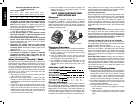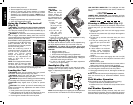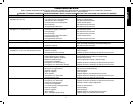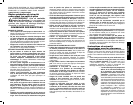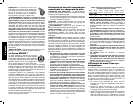
English
5
immediate medical attention. (Medical note: The
liquid is 25-35% solution of potassium hydroxide.)
• Charge the battery packs only in D
EWALT chargers.
• DO NOT splash or immerse in water or other liquids.
• Do not store or use the tool and battery pack in
locations where the temperature may reach or
exceed 105°F (such as outside sheds or metal
buildings in summer).
DANGER: Electrocution hazard. Never attempt to open
the battery pack for any reason. If battery pack case is
cracked or damaged, do not insert into charger. Electric
shock or electrocution may result. Damaged battery packs
should be returned to service center for recycling.
NOTE: Battery storage and carrying caps
are provided for use whenever the battery is
out of the tool or charger. Remove cap before
placing battery in charger or tool.
WARNING: Fire hazard. Do not store or
carry battery so that metal objects can
contact exposed battery terminals. For example, do not
place battery in aprons, pockets, tool boxes, product kit
boxes, drawers, etc., with loose nails, screws, keys, etc.
without battery cap. Transporting batteries can possibly
cause fires if the battery terminals inadvertently come
in contact with conductive materials such as keys,
coins, hand tools and the like. The US Department of
Transportation Hazardous Material Regulations (HMR)
actually prohibit transporting batteries in commerce or on
airplanes (i.e., packed in suitcases and carry-on luggage)
UNLESS they are properly protected from short circuits. So
when transporting individual batteries, make sure that the
battery terminals are protected and well insulated from
materials that could contact them and cause a short
circuit.
CAUTION: Battery pack must be securely attached to
tool. If battery pack is detached, personal injury may result.
The RBRC™ Seal
The RBRC™ (Rechargeable Battery
Recycling Corp oration) Seal on the nickel
cadmium and nickel metal hydride batteries
(or battery packs) indicate that the costs to
recycle these batteries (or battery packs) at
the end of their useful life have already been
paid by D
EWALT. In some areas, it is illegal to place spent
nickel cadmium and nickel metal hydride batteries in the
trash or municipal solid waste stream and the RBRC
program provides an environmentally conscious
alternative.
RBRC™ in cooperation with D
EWALT and other battery
users, has established programs in the United States and
Canada to facilitate the collection of spent nickel cadmium
and nickel metal hydride batteries. Help protect our
environment and conserve natural resources by returning
the spent nickel cadmium and nickel metal hydride batteries
to an authorized DEWALT service center or to your local
retailer for recycling. You may also contact your local
recycling center for information on where to drop off the
spent battery.
RBRC™ is a registered trademark of the Rechargeable Battery
Recycling Corporation.
Important Safety Instructions for
Battery Chargers
SAVE THESE INSTRUCTIONS: This manual contains
important safety instructions for battery chargers.
• Before using charger, read all instructions and cautionary
markings on charger, battery pack, and product using
battery pack.
DANGER: Electrocution hazard. 120 volts are present at
charging terminals. Do not probe with conductive objects.
Electric shock or electrocution may result.
WARNING: Shock hazard. Do not allow any liquid to get
inside charger. Electric shock may result.
CAUTION: Burn hazard. To reduce the risk of injury,
charge only D
EWALT nickel cadmium rechargeable
batteries. Other types of batteries may burst causing
personal injury and damage.
CAUTION: Under certain conditions, with the charger
plugged in to the power supply, the exposed charging
contacts inside the charger can be shorted by foreign
material. Foreign materials of a conductive nature such as,
but not limited to, steel wool, aluminum foil, or any buildup of
metallic particles should be kept away from charger cavities.
Always unplug the charger from the power supply when
there is no battery pack in the cavity. Unplug charger before
attempting to clean.
• DO NOT attempt to charge the battery pack with any
chargers other than the ones in this manual. The
charger and battery pack are specifically designed to
work together.
• These chargers are not intended for any uses other
than charging D
EWALT rechargeable batteries. Any
other uses may result in risk of fire, electric shock or
electrocution.
• Do not expose charger to rain or snow.
• Pull by plug rather than cord when disconnecting
charger. This will reduce risk of damage to electric plug
and cord.
• Make sure that cord is located so that it will not be
stepped on, tripped over, or otherwise subjected to
damage or stress.
• Do not use an extension cord unless it is absolutely
necessary. Use of improper extension cord could result
in risk of fire, electric shock, or electrocution.
• An extension cord must have adequate wire size
(AWG or American Wire Gauge) for safety. The
smaller the gauge number of the wire, the greater the
capacity of the cable, that is 16 gauge has more capacity
than 18 gauge. When using more than one extension
to make up the total length, be sure each individual
extension contains at least the minimum wire size.
CAUTION: When not in use, place tool on its side on
a stable surface where it will not cause a tripping or
falling hazard. Some tools with large battery packs will
stand upright on the battery pack but may be easily
knocked over.
• The label on your tool may include the following symbols.
The symbols and their definitions are as follows:
V ...........volts A .............amperes
Hz .........hertz W ............watts
min .......minutes
...........alternating
....direct current ................current
.........Class I Construction
n
o ...........no load
.............(grounded) ................speed
.........earthing terminal
...........safety alert
.........Class II Construction ................symbol
.............(double insulated) …/min .....revolutions or
BPM .....beats per minute ................reciprocation
............. ................per minute
BEFORE OPERATING THIS TOOL, CAREFULLY READ
AND UNDERSTAND ALL INSTRUCTIONS IN THE
“IMPORTANT SAFETY INSTRUCTIONS” SECTION.
Important Safety Instructions
for Battery Packs
Your tool uses a DEWALT battery pack. When ordering
replacement battery packs, be sure to include catalog
number and voltage: Extended Run-Time battery packs
deliver more run-time than standard battery packs. Consult
the chart at the end of this manual for compatibility of
chargers and battery packs.
NOTE: Your tool will accept either standard or Extended
Run Time battery packs. However, be sure to select proper
voltage. Batteries slowly lose their charge when they are
not on the charger, the best place to keep your battery is
on the charger at all times.
The battery pack is not fully charged out of the carton.
Before using the battery pack and charger, read the
safety instructions below. Then follow charging procedures
outlined.
READ ALL INSTRUCTIONS
• DO NOT incinerate the battery pack even if it is
severely damaged or is completely worn out. The
battery pack can explode in a fire.
• A small leakage of liquid from the battery pack cells
may occur under extreme usage or temperature
conditions. This does not indicate a failure. However,
if the outer seal is broken and this leakage gets on your
skin:
a. Wash quickly with soap and water.
b. Neutralize with a mild acid such as lemon juice or
vinegar.
c. If battery liquid gets into your eyes, flush them with
clean water for a minimum of 10 minutes and seek








